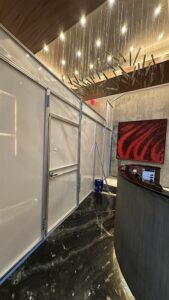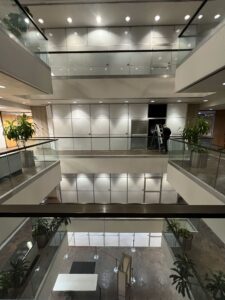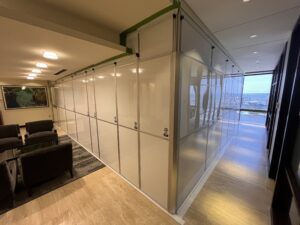Understanding ASTM, NFPA, and ICRA Standards for Modular Walls
Modular walls have revolutionized how facility managers approach temporary containment and construction projects. These versatile temporary wall systems provide flexible solutions for healthcare facilities, educational institutions, corporate environments, and government buildings. However, selecting the right modular wall solution requires more than just considering size and aesthetics—understanding the critical classifications and standards that govern their use is essential for ensuring safety, compliance, and operational success.
Whether you’re managing a hospital renovation, coordinating construction in an occupied office building, or overseeing maintenance projects in a school, adherence to established standards protects both your facility and its occupants. The American Society for Testing and Materials (ASTM), National Fire Protection Association (NFPA), and Infection Control Risk Assessment (ICRA) guidelines each play vital roles in determining which temporary containment solutions will meet your project’s requirements.
This comprehensive guide explores these three critical standard frameworks and their specific applications to modular wall systems. By understanding these classifications, facility managers can make informed decisions that prioritize safety, ensure regulatory compliance, and minimize project risks.
ASTM Standards: The Foundation of Material Performance
The American Society for Testing and Materials establishes comprehensive standards that define how construction materials and systems must perform under various conditions. For temporary walls and modular containment systems, several ASTM standards directly impact product selection and installation practices.
ASTM E119 addresses fire-resistance testing, establishing standardized methods for evaluating how wall assemblies respond to fire exposure. This standard determines fire-resistance ratings that facility managers rely on when selecting temporary containment for projects near sensitive areas or critical infrastructure. Modular walls meeting ASTM E119 requirements provide documented performance levels, enabling facility managers to specify appropriate fire-resistance ratings for their specific applications.
Structural performance standards under ASTM E72 evaluate wall systems’ ability to withstand various loads and stresses. These standards become particularly important when temporary walls must support equipment, withstand air pressure differentials, or maintain structural integrity in high-traffic areas. Facility managers coordinating construction in occupied buildings benefit from understanding these structural requirements to ensure temporary containment remains stable throughout project duration.
Material testing standards within the ASTM framework address durability, chemical resistance, and environmental performance. For healthcare facilities requiring frequent cleaning and disinfection, ASTM standards help identify modular wall materials that maintain integrity when exposed to cleaning agents and sterilization procedures. Similarly, educational facilities benefit from ASTM-compliant materials that withstand daily wear while maintaining appearance and functionality.
Real-world applications of ASTM standards become evident during major renovation projects. A hospital expanding its emergency department, for example, requires temporary walls that meet specific fire-resistance ratings while accommodating medical gas lines and electrical systems. ASTM-compliant modular walls provide the documented performance data facility managers need to satisfy code officials and insurance requirements.
NFPA Standards: Prioritizing Fire Safety and Prevention
The National Fire Protection Association develops and maintains fire safety standards that directly impact how temporary containment systems must be designed, installed, and maintained. For facility managers overseeing construction in occupied buildings, NFPA standards provide essential guidance for maintaining fire safety during temporary installations.
NFPA 101, the Life Safety Code, establishes requirements for egress, fire protection, and occupant safety that apply to temporary installations. When modular walls create new corridor configurations or alter existing egress paths, facility managers must ensure compliance with NFPA 101 requirements. This standard addresses corridor widths, exit access, and emergency evacuation procedures that temporary containment installations must accommodate.
Fire prevention standards under NFPA 1 provide comprehensive guidance for maintaining fire safety during construction and renovation projects. These standards address hot work permits, temporary heating systems, and construction material storage—all considerations that interact with temporary wall installations. Facility managers benefit from understanding how modular containment systems can support NFPA 1 compliance by providing secure storage areas and controlled access zones.
NFPA 13 addresses automatic sprinkler system requirements, including provisions for temporary installations and modifications during construction. Modular wall systems that integrate with existing fire protection systems or accommodate temporary sprinkler modifications help facility managers maintain NFPA 13 compliance throughout construction projects.
Healthcare facilities face additional NFPA requirements under NFPA 99, which addresses health care facilities’ fire safety and emergency management. When implementing temporary containment in hospitals or medical facilities, modular walls must accommodate medical gas systems, emergency power requirements, and specialized ventilation systems while maintaining NFPA 99 compliance.
The practical application of NFPA standards becomes clear during complex renovation projects. An airport terminal renovation, for instance, requires temporary walls that maintain required egress widths, accommodate fire suppression systems, and provide appropriate fire-resistance ratings—all while allowing continued passenger operations. NFPA-compliant modular walls enable facility managers to maintain safety standards without compromising operational requirements.
ICRA Guidelines: Infection Control in Healthcare Settings
Infection Control Risk Assessment guidelines provide essential frameworks for managing infection risks during construction and renovation projects in healthcare facilities. For facility managers overseeing medical facility projects, ICRA guidelines determine how temporary containment must be designed and implemented to protect patients, staff, and visitors.
ICRA classification systems categorize construction projects based on their infection risk potential, with each class requiring specific containment measures. Class I projects involve minimal dust generation and require basic precautions, while Class IV projects involve major demolition requiring complete containment with negative air pressure systems. Facility managers must understand these classifications to select appropriate modular wall systems and containment strategies.
Airborne infection isolation requirements under ICRA guidelines specify how temporary containment must manage air pressure differentials and filtration. Modular walls used in healthcare settings often require integration with HEPA filtration systems and negative air machines to maintain appropriate pressure relationships and prevent contamination spread. These systems must accommodate medical gas lines, electrical systems, and emergency equipment while maintaining infection control barriers.
Dust and debris containment represents another critical ICRA consideration, particularly during demolition and renovation activities. Temporary walls must provide complete barriers that prevent particulate migration into occupied areas while accommodating construction access requirements. Facility managers benefit from modular systems that offer multiple access options, including personnel doors, equipment openings, and emergency egress points.
Water damage prevention and moisture control fall within ICRA guidelines, addressing how temporary containment manages humidity and prevents mold growth. Healthcare facilities require modular wall systems that resist moisture while accommodating necessary ventilation and climate control systems. These requirements become particularly important in areas housing immunocompromised patients or sterile processing departments.
Real-world ICRA applications demonstrate the complexity of healthcare construction management. A cancer treatment center renovation requires Class IV containment measures, including complete dust barriers, negative air pressure systems, and specialized access controls. Modular walls that integrate these requirements enable facility managers to maintain patient care operations while ensuring construction safety.
Benefits of Standards Compliance
Adherence to ASTM, NFPA, and ICRA standards provides facility managers with multiple operational and risk management advantages. Compliance ensures regulatory approval, reduces liability exposure, and supports operational continuity during construction projects.
Safety improvements represent the primary benefit of standards compliance. Modular walls meeting established standards provide documented performance levels for fire resistance, structural integrity, and infection control. Facility managers can rely on these performance specifications to maintain safe conditions for building occupants during construction activities.
Regulatory compliance becomes streamlined when temporary containment systems meet established standards. Building officials, fire marshals, and health department inspectors recognize ASTM, NFPA, and ICRA standards, expediting permit approval processes. This recognition reduces project delays and ensures construction can proceed according to schedule.
Risk mitigation through standards compliance protects both facility operations and organizational reputation. Insurance providers often require compliance with established standards, and documented adherence can reduce premium costs and liability exposure. Facility managers benefit from the protection that standards compliance provides against potential claims or regulatory penalties.
Operational efficiency improves when modular wall systems integrate seamlessly with existing building systems while meeting all applicable standards. Properly specified temporary containment enables continued facility operations without compromising safety or compliance requirements.
Ensuring Project Success Through Standards Compliance
Understanding ASTM, NFPA, and ICRA standards enables facility managers to make informed decisions about temporary containment solutions. These standards provide the foundation for safe, compliant construction projects that protect building occupants while enabling necessary facility improvements.
Compliance with established standards reduces project risks, expedites regulatory approvals, and supports operational continuity. When you choose modular wall systems that meet these critical requirements, you’re selecting solutions that prioritize safety and performance.


